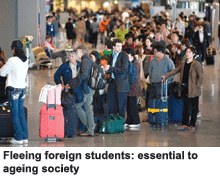The financial future of some Japanese universities is in jeopardy following the exodus of many thousands of foreign students in the wake of the massive earthquake, tsunami and potential nuclear catastrophe that hit the country in March. More than 15,000 people were killed in the devastation that resulted from the natural disasters suffered by the north-east of the nation.
The foreign students who subsequently fled the country included tens of thousands of Chinese, who make up the vast majority of the overseas contingent at Japan’s universities. The exodus has left Chinese students contemplating ruined studies, but it has also highlighted the fact that overseas recruitment is essential to many universities in Japan, an ageing society where the inflow of home students has reduced.
 Keenly aware that foreign students will be missed at many levels, the education ministry’s responses included buying free return tickets for foreign students who are hesitant about returning to Japan. In another scheme, aimed at bringing back tourists, the ministry is paying students to take short holidays around Japan and then report their experiences on Twitter.
Keenly aware that foreign students will be missed at many levels, the education ministry’s responses included buying free return tickets for foreign students who are hesitant about returning to Japan. In another scheme, aimed at bringing back tourists, the ministry is paying students to take short holidays around Japan and then report their experiences on Twitter.
For university lecturers in Japan, March was the spring recess and academic life was due to rekindle only on April 1. “It was vacation time, so teachers were relatively free to travel,” says Paul Snowden, a former dean at Waseda University, Tokyo. “The quake itself, even in Tokyo, hundreds of miles from the epicentre, was strong enough to scare anyone. And the following few days of paralysed transport, no phones and panic buying of rice, water, toilet paper, batteries and petrol was quite enough to persuade those who could to get out.”
And flee they did. According to the justice ministry, more than 470,000 foreigners left the country, at least temporarily, between March 12 and April 1. More than 70,000 of the 86,000 Chinese students left the country in March. The sudden stampede closed down local Chinese restaurants, now bereft of student labour. Of those 70,000 Chinese students who left, 22,000 remain absent. Parental pressure, particularly from one-child families in China, has a great bearing on those decisions to quit Japan, says Snowden.
To shore up its ailing universities, pre-quake Japan had formulated the ‘300,000 International Students Plan’ with the aim of boosting its foreign student intake by 2020. Japanese universities have suffered in international rankings because of their sparse numbers of international students and staff. Only two of the country’s institutions appear in the top 100 of the Times Higher Education World University Rankings. “We value our foreign students... We are keen to invite more students to Japan,” says Junsaku Mizuhata of the ministry’s higher education bureau.
(Excerpted and adapted from Times Higher Education)